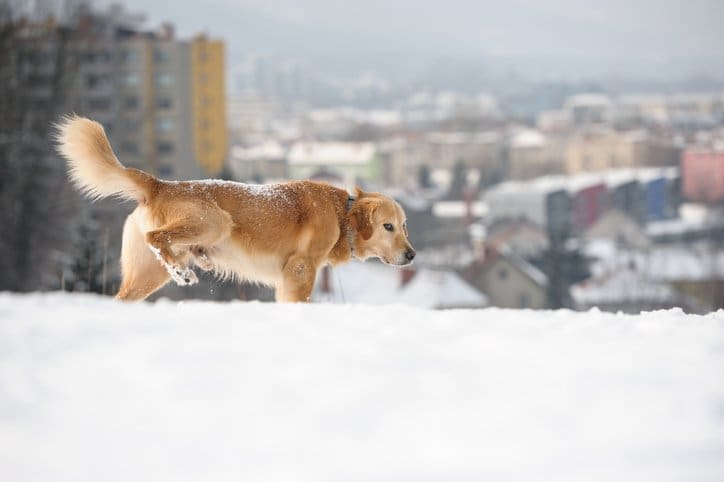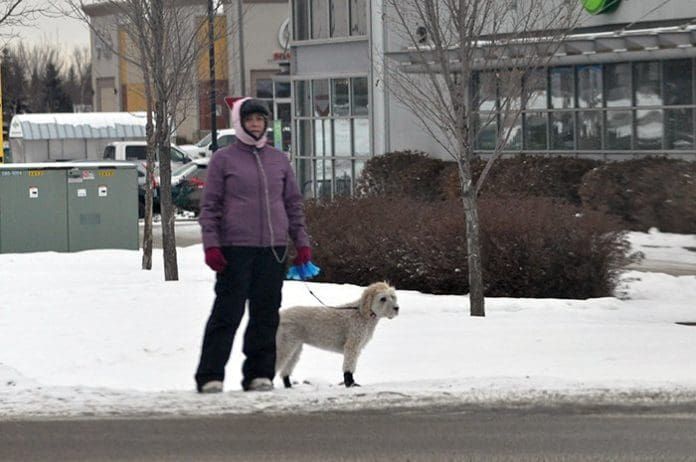When temperatures hit near- or below-zero, you may need to strongly encourage your dog to potty – actually, insist on it! Veterinarians see spikes in the number of cases of urinary tract infections in winter, when dogs tend to “hold it” for as long as possible, declining invitations to go outside at their usual potty times, and failing to take the time to empty their bladders fully when they do go outside. The longer urine is held in the body, the more bacteria can grow in that urine; when the population of bacteria tips past a level that the dog’s immune system can control, discomfort and systemic illness can result.

You may need to encourage your dog to drink adequate amounts of water when it’s super cold, too. Many dogs become reluctant to drink when it’s cold, and end up getting dehydrated, which can set the stage for a wide constellation of disorders, especially in senior dogs. If you come home from work and your dog’s water bowl has gone untouched all day – it’s at the exact level where it was when you filled it fresh that morning – you should start experimenting to find whatever works best to get your dog to drink more. Some effective tactics include filling the bowl with fresh water more frequently; warming the water to something more than room temperature; or adding bone broth, chicken broth, or even a bit of honey to the water. Feeding him a high-moisture food will also help, whether it’s canned, fresh home-prepared, raw frozen, or simply his regular kibble soaked in warm water or broth.
Assuming your dog is drinking enough, here are some tips for encouraging him or her to potty as fully and often as usual:
If you can, make a designated potty station outdoors. A covered outdoor area, preferably a spot with some protection from driving wind, is very helpful. Put down anything that will help protect your dog’s paws from the cold ground (or ice or snow): some straw or wood shavings work great, but a few squares of artificial turf (even if it’s just a door mat) that your dog can stand on to pee, will help. You can hose them off (or even toss them out) when the temperatures thaw! This is an emergency!
Some folks walk their dogs to the nearest parking garage, or set up a “potty box” in their own garage when the weather is too nasty to spend an adequate amount of time outside.
Do you live in an apartment or other urban setting where you have to potty your dog on walks? If so, we hope you have already invested in and accustomed your dog to wearing some sort of paw protection. Wearing boots can help protect his feet from freezing temperatures as well as potentially dangerous ice-melt substances that can be found on urban sidewalks.
Make sure you are bundled up, too! Trying to rush your dog into going potty quickly because you are freezing can backfire; back in the house, when you step in a puddle in your socks, or find a pile under the dining room table, you can go ahead and smack yourself over the head with a rolled-up newspaper. “Naughty owner!” Dress as warmly as possible and let your dog take her time outside.
Make sure you give your dog some extra-yummy rewards when he or she goes potty outdoors in extraordinary temperatures. Anything you can do to help your dog associate going outdoors with good things, rather than an aversive experience, will help keep him or her “regular,” and help prevent “accidents” in the house.







I have always accompanied my dogs when they needed to go out but due to my health, it’s getting a little more difficult to be out there with Lucy. How can I train her to go on a pad inside on certain days? She has always got outside. She’s never had an accident. How can we transition her to do it inside?